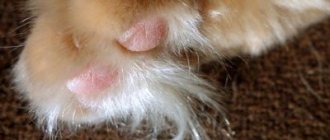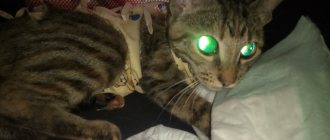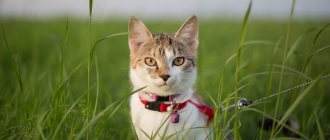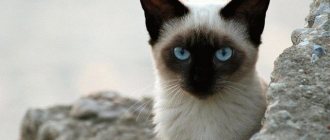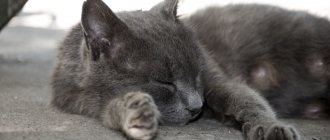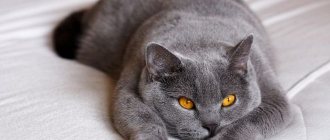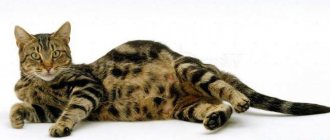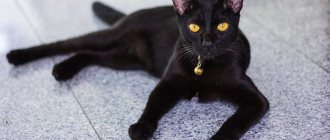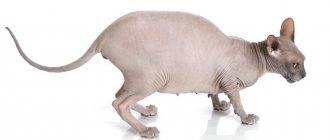Looking at the clenched or blissfully extended paws of a pet, we often ask ourselves the question: how many toes does a cat have? And when we try to count them, we can get completely unexpected results.
Cats usually have eighteen toes. Five on the front paws (with four located side by side, and the fifth at a distance) and four on the hind paws.
When walking, only four fingers touch the surface. The fifth toes on the front paws are intended exclusively for climbing.
Each of the fingers has a sharp sickle-shaped claw, which helps the animal to deftly climb tree trunks, repel the attacks of relatives and tenaciously grab fleeing game. Some intellectuals use their claws as an improvised fork: they prick pieces of food on them and put them in their mouths.
Cats have retractable claws. With the help of muscles and tendons, they are pulled into a kind of “sheath”, without preventing the animal from running, without touching hard surfaces and therefore without becoming dull. When the cat is ready to grab its prey, it spreads its fingers and releases its formidable weapon from its “sheath.” This feature is inherent in all representatives of the cat family, except the cheetah.
The structure of a cat's paws
The light, dancing gait of cats cannot fail to attract attention. Take a closer look: they walk on their toes, like ballerinas! The cat does not step on its heel when walking, the paw remains collected and rounded, and the sharp claws are securely hidden in special “cases.”
Nature has reliably protected cat fingers and claws
Cat's paws are perfection conceived and realized by nature and deserve a separate story. All joints and joints are endowed with extraordinary mobility, which not only ensures graceful movements, but also allows, if necessary, to run very quickly, jump high and far, and perform unimaginable somersaults and pirouettes. The motor reactions of this animal are faster and more accurate than those of any mammal.
Flexible and tenacious fingers allow cats to move on any surface
Fingers are especially flexible - each of them seems to live a separate life, moving, bending and unbending independently of all the others. Thanks to this, cats instantly find balance and stay on almost vertical, uneven, slippery, very risky surfaces.
The cat puts its paw on its toes, the heel remains high above the ground
The famous cat toe-walking is complemented by another gait feature called ambling. All cats are pacers: they alternately move all their right paws, and then the two left ones. This allows predators to confuse their tracks, for secret purposes accurately placing one fingerprint on another. In addition, ambling makes the cat more stable and maneuverable - it makes it possible to quickly develop speed and change the direction of movement.
The pacer cats can walk, accurately following the trail.
The fingers and claws on the front paws of all cats are designed to catch and hold prey - they are much weaker than the striking hind limbs. However, large predators are capable of inflicting significant damage on their prey with a powerful blow from their front paw. By the way, have you noticed which “hand” your cat uses more actively?
In a fight, all four paws are used - but the back ones are much more dangerous
Scratchy paws: counting a cat's toes
Cat paws have always attracted people's attention due to the combination of softness and noiselessness of movement with sharp claws on the fingers. This found expression even in folk art. “Soft paws, with scratchy paws” - this is how the children’s riddle voices the specificity of the limbs of furry pets. But the very structure of the toes on the animal’s paws is also interesting, because cats differ in this regard from other mammals.
Cat's fingers: structural features and functions
Representatives of the cat family normally have 18 toes on their paws, while other mammals boast limbs with twenty toes. However, thanks to this, our furry pets gain that special grace that is inherent only to cats.
Cats are special animals down to their toes.
Since cats are predatory animals, their paws are equipped with “cold weapons.” Despite the menacing appearance of the claws, these keratinized processes are very sensitive due to the presence of capillaries and nerve endings inside. Therefore, pets need to trim their nails with great care so as not to cause pain or damage to their fingers.
There are sharp retractable claws not only on the visible part of the limbs, but also where not every fan of purrs would think to look - on the lateral toes of the front paws, which are distinguished by their high and far apart location. Zoologists explain this structure by the need to climb tree trunks and other vertical objects.
Anatomically, cat toes are a combination of metacarpal bones, tendons, proximal and middle phalanges, as well as the outer phalanx and claw.
The structure of cat fingers is characterized by mobility and flexibility of joints.
Each front paw has five toes, four of which are directly involved in the cat’s movement, and the fifth is a rudiment. The hind legs already include four toes on each limb, and instead of the fifth there is a small tubercle on the surface of the feet.
The peculiarity of cats is that the fingers play the main role in moving the animal, because purrs do not step on the entire paw, but walk “on tiptoes.” In order to reduce the load on the toes, cats' feet acquired hard elastic pads during evolution - a large one in the middle of each paw and small ones next to each toe.
Polydactyly in cats
We have already mentioned above that there are situations when there are more than 5 fingers on a person’s limbs. This anomaly is called polydactyly. Moreover, for example, the hand may contain both fully developed extra fingers and rudimentary, defective ones.
Polydactyly also occurs in cats, when there are extra fingers on one, two, three, or all four limbs at once (even if the animal has at least one more finger than it should have normally, we can safely talk about polydactyly). By the way, unlike people, who have polyfingered fingers and feet with equal frequency, cats most often have additional fingers only on their front paws.
What are the causes of polydactylism in animals
? It's all about heredity: if either a cat or a female cat has the polydactyly gene, then with a high degree of probability (50%) at least one of their kittens will have extra toes.
How many toes can a cat with polydactyly have?
Usually 6 or 7, rarely 8. Let us remember that additional toes can be present on one foot or on all four. The maximum total number of fingers in a polydactic cat was recorded back in 1974: the animal had as many as 32 fingers instead of the usual 18!
In the old days, if a cat had more fingers than normal, people treated this fact differently:
- Norwegian sailors believed that it was polydacte cats that were much better than ordinary purrs at catching rodents on a ship. In addition, it was believed that such animals promised good luck to everyone on board, and also protected from storms and bad weather;
- In the 1750s in Europe they believed that cats with many toes were accomplices of witches. Often, innocent animals were burned along with sorcerers and witches (many of whom, like cats, were innocent);
- In the USA, for a long time, there has been a belief that stroking a many-toed cat is good luck;
- The 26th President of the United States, Theodore Roosevelt, and the American writer Ernest Hemingway had cats with abnormal limb structure. And the owners doted on their unusual tailed friends.
What to do if your cat has polydactyly
Surely every owner who notices an extra finger on their cat will want to find out whether polydactyly is dangerous.
We hasten to reassure you: in the vast majority of cases, additional fingers do not interfere, and even help the animal:
- Walk comfortably on freshly fallen snow;
- Swim (provided that the pet is not afraid of water);
- Climb up trees;
- Descend from heights and jump
- Successfully catch rodents;
- Open door and window handles;
- And even steal food from the table (although this ability is unlikely to please any owner).
It can be noted that polydactic cats look cute and funny due to their non-standard large paws. But it also happens that accessory fingers cause harm and pain to cats. Improper formation of the toes sometimes leads to the ingrowth of the claw into the soft flesh of the paw. It also happens that the extra toes are too long, so that when walking the animal constantly injures them and cannot fully walk or run.
And in some situations in animals with polydactyly, the joints and bones of the limbs suffer. Therefore, if the anomaly causes inconvenience, it is better to remove additional fingers from kittens at an early age. Or at least you should not be lazy and get advice from a veterinarian on this matter. But still, in most cases, polydactic cats are absolutely healthy pets. And they do not require any treatment.
How many fingers does a cat have?
Only an ignorant person can think that a cat, like him, has two dozen fingers on its “hands and feet.” Nothing of the kind - count for yourself: on each of the cat's front paws there are five fingers (four main and one dewclaw), and on the back paws there are only four fingers. The dewclaw (or false) finger is located separately on the front paw, just above the metacarpus, and is used only on inclined or vertical surfaces.
That is, the total number of fingers is eighteen - two less than the vast majority of other animals. But this is if we talk about ordinary cats. But there are also extraordinary ones - we will talk about them a little later.
An ordinary cat has four primary toes and one dewclaw on its front paw.
Were there any profits?
It is obvious that at the dawn of the glorious cat family, they, like all mammals, had five fingers on all four limbs. However, the cat led such a lifestyle that the fifth toe on its hind legs was not only not used, but also got in the way, which is why it began to gradually disappear in the process of development.
The front paws are a completely different matter. Although dewclaws stand apart from everyone else here, sometimes they help their owner a lot - for example, without them it would be much more inconvenient to climb trees.
If on the front paws the dewclaw is clearly visible, then on the hind paws there is no trace of it left.
If we draw an analogy with dogs, then puppies are often born with underdeveloped false toes on their hind legs. To avoid injury, they are removed for babies in the first days or even the first hours of life. The only exceptions are some breeds where the hindquarters are a sign of the standard (for example, Briards and Pyrenean Mastiffs).
In cats, evolution has advanced further, and such a rudimentary manifestation is almost never observed in newborn kittens. On the metatarsal bones of the hind limbs, only a barely noticeable hint of the fifth toe remained.
A haircut
Unlike their wild relatives, modern pets lead a less active lifestyle and do not have time to wear them down. They constantly grow back and even a scratching post is not effective.
The fifth toe on the front paws is especially dangerous; it is located higher than the rest and the claw is too long and can begin to grow in or prick the paw pads, causing pain. In addition to its own discomfort, the pet can cause damage to furniture or scratch its owners.
You can tidy up your animal’s paws yourself if you have the skills to use special scissors.
Before starting the procedure, carefully examine the paw and claws; their ends are light and the base is dark - the pulp. It contains blood vessels and cannot be touched, much less cut. It bleeds blackish and can cause inflammation.
The circumcision process itself is painless, but some cats become nervous and even show aggression. Therefore, sometimes it is better to carry out manicure procedures together, so that one holds the pet and the other cuts the hair.
When trimming your nails, follow these guidelines:
- To begin, take the cat and calm it down, pet it, talk to it. Place him on your lap. Take the paw in your left hand (for right-handers), fix your pet’s finger between your thumb and forefinger, lightly press on the pad and a nail plate will appear;
- Determine the area of the nail from the pulp, it should be a light tip;
- The nail clippers should be positioned perpendicular to the nail and cut off the claw in one motion. If you place them parallel, this can lead to delamination of the plate;
- If sharp corners have formed, they can be cut off with a regular manicure file;
- All other claws should be trimmed using the same principle.
After completing the process, treat your pet with a treat so that he remembers and will not be nervous next time when grooming.
The veterinarian will cut the hair correctly and clearly show it. After that you can try it yourself. If you are not confident in your abilities, then contact your doctor once a month to repeat the procedure.
Nowadays, many attributes have been invented for animals, but if your pet damages furniture or gets scratched badly when playing, you can put silicone attachments on its claws. Safe and does not cause discomfort to the pet. True, if the cat doesn’t like it, he can make an effort and remove them.
Some owners use complete declawing to preserve furniture and expensive coverings in the house. This is a huge stress and health hazard for the animal.
The structure of a cat's paws
Cat toes have soft pads that are not covered with fur. Sharp claws grow on each of the pads, thanks to which the cat can deftly climb a tree, firmly grab prey, or defend itself from an attacking enemy. The extension and retraction of a cat's claws occurs due to a special retractable structure. The process is carried out with the help of muscles and tendons. When a cat moves along a horizontal surface, the claws on its paws are retracted inward. But if necessary, the claws are released. Splayed fingers topped with razor-sharp claws are a dangerous weapon and a deadly trap for prey.
How many toes are there on the front and hind paws?
Cats' paws are designed in a special way, thanks to which the claws can be extended and retracted at the pet's request. The animal has 5 toes on its front paws and 4 on its hind paws. Of the 5 fingers, 4 grow on the same line, and the fifth, rudimentary, is placed a little higher. The thumb does not touch the surface when the cat walks, but when climbing onto a vertical surface it functions as a grasping grip.
Each limb of an animal has a certain number of fingers.
Main functions
In the movement of a cat, fingers play one of the most important roles. This is due to the fact that the animal does not step on the foot completely, but moves around while standing on tiptoes. In addition, there are other functions:
- Ensuring balance.
- Tactile sensitivity. The animal's pads detect the slightest vibrations of the surface as prey moves along it.
- Saving sustainability. On the front and hind paws, each toe moves independently of the others. This is an important feature, thanks to which the animal can easily maneuver the position of its paws, and with the help of its fifth toe, freely climb onto surfaces, even those placed at right angles to the ground.
- Even distribution of load when jumping. Soft pads evenly distribute the shock load at the moment of landing, so the animal is not susceptible to limb injuries.
What is polydactyly
Sometimes it happens that a cat is born with a few extra toes. This is a genetic trait called polydactyly.
The extra fingers may be aligned with the other four or spaced apart from them, like a human's thumbs. The first option is called postaxial polydactyly, and the second is called preaxial. Paws with spaced toes are called “mittens”, and wide multi-toed feet are called “snowshoes”. Neither form of polydactyly causes animals the slightest inconvenience. This is not a deformity, but only a structural feature.
An abnormal number of toes can be present in both male and female cats. Most often, this phenomenon occurs on the forelimbs or simultaneously on the front and hind limbs. Cases of hind limb polydactyly are extremely rare.
How to trim a cat's claws
Before trimming, determine where the blood vessel ends on the nail.
It is very important not to damage it! Never cut your nails short - you risk damaging a blood vessel, causing bleeding and causing pain and stress to your cat.
Never cut your nails short, as you risk damaging a blood vessel, causing bleeding, and causing pain and stress to your cat.
If you damage a vessel, stop the bleeding with hydrogen peroxide.
Using anti-scratch pads
Anti-scratch pads are “soft claws”. Special caps made of silicone, glued to the cat's claws. These tips stay on the claws for 4 to 8 weeks, preventing scratching.
It is important to consider the pros and cons before undertaking this procedure.
“Soft claws” do not allow cats to grind their claws down on their own, so there remains a need to trim them periodically.
In addition, when using soft claws, the cat does not have the ability to claw, which can limit its movement around the house.
Before purchasing silicone pads for your cat, you should listen to the advice of your veterinarian:
Consult your veterinarian before performing this procedure, as the cat may have an individual intolerance or allergy to glue.
The caps will most likely have to be removed and the animal given appropriate treatment.
- Apply silicone caps only to healthy animals that do not have fungal or infectious lesions. If there are wounds or irritation on the pads and between the toes, it is better to abandon soft claws for a while and treat the animal.
- Carefully apply the caps and regularly inspect the claws for infectious and fungal diseases, as various microorganisms can accumulate between the cap and the pad.
- Inspect the extremities daily for skin tension, which may be the result of inaccurate application of the adhesive.
Cat's claws are peeling - how to help
Cats' claws consist of several layers. Running the claws into a hard surface helps peel off the top layer, revealing a new, strong, sharp-tipped bottom layer.
Causes of claw delamination:
- Natural renewal of the stratum corneum;
- Incorrect haircut;
- Avitaminosis.
The natural separation of a cat's claws occurs approximately once every two months - this means their growth. Animals themselves remove the unnecessary layer in the process of “turning” or remove it, like a small cover, with their teeth.
Breeding wide-footed cats
Broad-footed Maine Coon breeds are bred in nurseries based on breeding programs, where the corresponding gene is passed on between generations. To produce offspring with polydactyly, one parent must have a foot anomaly - then the birth of offspring with polydactyly is possible with a probability of 56% (not all kittens in the litter are polydactylic).
If you breed two wide-legged animals, the likelihood of having polydact kittens increases by another 20%. Mating, where one parent is a homozygous polydact, leads to the fact that the entire litter will be polydactyl.
Polydactyly in cats
The polydactyly gene behaves unpredictably. It is expressed differently in offspring, regardless of the combination of fingers of the parents. In contrast to other dominant genes, it manifests itself in different ways in both homo- and heterozygous forms.
Breeders of broad-toed cats continue to conduct statistical work, trying to discover more accurate information about the likelihood of producing multi-toed kitten offspring.
Be sure to read:
Caring for an amazing raccoon cat - Maine Coon
Positive and negative properties of polydactyly
Polydactyly has many advantages:
- A cat with extra toes can be easily held on any surface;
- Can move quickly in the snow or swim;
- Uses door handles freely for their intended purpose;
- It walks completely silently and can sneak up very close to its prey;
- With great dexterity, he catches fish in a stream or home aquarium.
However, in some cases, a completely different gene may be responsible for the development of polydactylism - the one that causes deformed limbs in cats, bent joints, and ingrown claws. Such animals require treatment at a veterinary clinic.
The most dangerous deviation is a thumb with three phalanges. Animals with this defect may give birth to underdeveloped kittens. Individuals with three-phalanx fingers are subject to mandatory sterilization.
Usually the gene that is responsible for the presence of polydactyly is inherited. If at least one of the parents has more fingers than normal, some of the offspring will necessarily be multi-fingered. But since this is a recessive gene, the remaining kittens will have completely normal legs.
Indications for use
The medicinal properties of cat's claw include:
- Detoxifying effects. The drug helps cleanse cells, improves liver function, helps cope with poisoning of various etiologies (alcohol, medication, poisoning by chemical emissions, etc.), and also removes excess fluid from the body.
- Immunomodulatory effects. The plant strengthens and heals the human immune system, increasing resistance to colds and infections.
- Recovery after a course of chemotherapy and radiation therapy. The drug gently and carefully restores impaired body functions, since radiation and chemotherapy are a difficult test for internal systems and organs.
- Anti-inflammatory effect. The drug helps relieve or reduce inflammatory processes in joints and internal organs.
- Antitumor effect. Cat's claw slows down the development of cancer.
- Acceleration of the healing process of ulcers. The drug promotes mild scarring of ulcers in the stomach and duodenum.
- Cardioprotective effects. The drug prevents the formation of blood clots and cholesterol “plaques” inside blood vessels, therefore it is used as a prevention of atherosclerosis. At the same time, the drug normalizes blood pressure, which is especially important for hypertensive patients.
- Antiparasitic effect. The drug has a detrimental effect on both adult parasites and their larvae.
Cat's fingers: structural features and functions
Representatives of the cat family normally have 18 toes on their paws, while other mammals boast limbs with twenty toes. However, thanks to this, our furry pets gain that special grace that is inherent only to cats.
Cats are special animals down to their toes.
Since cats are predatory animals, their paws are equipped with “cold weapons.” Despite the menacing appearance of the claws, these keratinized processes are very sensitive due to the presence of capillaries and nerve endings inside
Therefore, pets need to trim their nails with great care so as not to cause pain or damage to their fingers.
Anatomically, cat toes are a combination of metacarpal bones, tendons, proximal and middle phalanges, as well as the outer phalanx and claw.
The structure of cat fingers is characterized by mobility and flexibility of joints.
Each front paw has five toes, four of which are directly involved in the cat’s movement, and the fifth is a rudiment. The hind legs already include four toes on each limb, and instead of the fifth there is a small tubercle on the surface of the feet.
The peculiarity of cats is that the fingers play the main role in moving the animal, because purrs do not step on the entire paw, but walk “on tiptoes.” In order to reduce the load on the toes, cats' feet acquired, during evolution, hard elastic pads - a large one in the middle of each paw and small ones next to each toe.
A cat's toes are a tool for transmitting information and a shock absorber at the same time
In addition, the toes on the paws of representatives of the cat family perform the following functions:
- Maintaining balance and tactile sensitivity. In other words, it is the toes on the animal’s paws that help to detect even minor vibrations from the movement of mice and other rodents. The other side of the coin is the susceptibility to damage to the skin of the toe pads, which can cause the pet’s health to deteriorate significantly.
- Maintaining sustainability. Due to the fact that each toe on a cat's paw moves independently of the others, the purr can freely climb up and down trees. Moreover, the furry pet does such tricks even on vertical surfaces with an angle of 90 degrees.
- Cushioning during jumps from high heights. Elastic pads on the fingers muffle the impact of the ground and save animals from injury to their limbs.
- Maintaining cleanliness. The desire of cats to wash themselves is evident as early as 4 months of age, and the procedure itself has become the subject of popular superstition. So, if a cat simply licks its paws, then this promises a change in the weather, and if it sits on the threshold at the same time, it means waiting for guests. In fact, the desire to keep themselves clean is due to the nature of cats, because these predators must remain invisible while hunting. In addition, due to frequent licking of the paws, the skin on the pads becomes moisturized, becoming soft and elastic.
- Transferring information about the animal to other representatives of the cat fauna. After all, on a cat’s fingers and between them there are special glands that secrete a specific smell. When a cat scratches a fence post or a tree trunk with its claws, the pet thus communicates to other purrs about its claim to a certain territory and, as a result, to the females living there.
Anomalies in the development of fingers in cats: what to do
A caring owner will probably be worried when he discovers that his pet has an extra finger. Does anything need to be done about this?
Extra fingers are often an advantage in a cat's life. Thanks to them, village cats will dexterously circle around the yard covered with fresh snow, climb trees, and hunt mice. If you have a domestic cat, there is no reason to worry either: polydactyly is not a disease. Take your pet to the vet to be sure that extra fingers are not bothering your cat.
Polydactyly is usually not dangerous for kittens.
If they are deformed or poorly positioned, the cat may have health problems:
- incorrect finger structure leads to ingrown claws;
- a large length can interfere with walking;
- If the load on the paws is incorrect, the joints wear out faster. Then the surgeon will be able to help the animal.
Interesting facts about cats' paws and toes
Did you know that cats can also be left-handed or right-handed, using their paws and toes to varying degrees? Moreover, recent studies by German and French veterinarians have proven an amazing fact: it turns out that many cats have “preferred” paws. Simply put, some right-handers still prefer to use their left paw when hunting mice.
Experts from Queens University (Ireland) suggest that the division into right-handed and left-handed animals among animals largely correlates with gender. It is believed that among cats there are more left-handers, while among males right-handers predominate. Interestingly, humans (as well as other primates) have exactly the same “gender” division.
You can easily find out which group your pet belongs to: just watch which paw he uses to fish out a treat from under the furniture. In addition, you can simply play with the cat using a bow on a string for this purpose.
The role of fingers in walking
Due to the contraction of the flexors and their sharp relaxation, cats can make impressive jumps. Finally, due to the “finger” movement, these animals can walk very quietly (almost inaudibly), which is also ideal for all nocturnal predators, which are what domestic cats are.
The role of fingers in tactile sensitivity
Have you ever wondered why cats constantly “feel” with their paws any things and objects that somehow aroused their interest? It's all about the incredible sensitivity of the fingertips. They are literally riddled with nerve endings. Moreover, the latter help the animal not only feel the texture of the surface on which the cat walks, but also participate in maintaining balance. In addition, the receptors are incredibly sensitive: it is known that the pads of a cat's fingers can feel even such minor vibrations that occur when moving mouse-like rodents.
Deviations from the norm
Cats, like people, have deviations from the norm. For the animal itself, a different number of toes on the paws does not pose any problems and does not affect the quality of life in any way. On the contrary, it gives a good advantage over its peers if there is an “extra” finger, or polydactyly.
There are two types of polydactyly:
- postaxial - the toes grow in a row with the main ones, as a result the paw resembles a snowshoe;
With postaxial polydactyly, “extra” fingers grow flush with the main ones
Preaxial polydactyly is characterized by extra toes on the inside of the paw
Polydactyly is most common in the Maine Coon breed. Up to 40% of individuals have additional toes on the hind and front paws. Felinologists believe that this is due to the origin of the breed from the northeastern part of America. In winter, a lot of snow falls there, and it is much more convenient for polydacts to move through the snowdrifts (the “snowshoe” paws do not sink deep).
Video: Maine Coon kitten - polydact
In my opinion, it is in Maine Coons that polydactyly looks especially cute. After all, their paws are already quite large and wide. I don’t know what “extra” fingers would look like on an ordinary barn cat. In my life I have never seen anything like this.
Causes of the anomaly
The cause of this anomaly is a genetic mutation caused by an autosomal gene. This means that the mutated gene will overlap the healthy one. Therefore, if one of the kitten’s parents has polydactyly, then the baby will either be born with polydactyly or will be a carrier of the gene and pass it on to the next generation.
Who are ship cats?
Ship cats are polydactic cats. They got their name thanks to sailors who kept cats on ships to fight rodents and noticed that polydacts were much more stable on deck during a storm, unlike their brothers. Sailors were more willing to take just such animals on board, attributing to them the ability to bring good luck and protect them from troubles.
Sailors still believe that a cat on a ship brings good luck.
Interesting facts about polydacts
The polydactyl gene is strictly monitored in purebred cats. The requirements for breed standards are immutable, and polydacts are strictly excluded from breeding.
And in Belgium and Holland, a movement has been organized to revive the stock of Maine Coons with extra fingers as a separate direction of the breed, indicating its aboriginality.
It is noteworthy that polydactic cats are very popular. US President Theodore Roosevelt adored his pet polydactus named Slippers. The six-toed cat Snowball was Hemingway's favorite. By the way, now on the island of Key West, more than forty cats live in the writer’s house-museum, all of them are six-toed and are direct descendants of the writer’s pet.
The Guinness Book of Records boasts such specimens as Jake the cat (he had 28 fingers) and a cat named Tiger, the owner of 27 fingers.
How many toes does a cat have: the norm on the hind and front paws, possible pathologies
Cat paws always attract the attention of owners with their softness and ability to move silently. But these scratchy paws are armed with sharp claws.
People become attached to pets and try to find human traits in them. For example, they count how many fingers a pet has and are happy if the cat and the owner have the same number of fingers. And they get upset if their number on a person’s hind legs and legs does not match. So how many toes does a cat actually have? This article talks about this.
How many fingers does a cat have?
A person has five fingers on his feet and hands. How much does a cat have? At first glance, there are four on the apron and hind legs.
But, if you take the front paw in your hands, a spiny formation can be felt a little higher. This is the fifth finger. Evolution left it for cats to climb trees.
It is known that people have abnormalities; fingers may be missing from birth. This condition is called ectrodactyly. When there are more fingers than normal, they talk about polydactyly. Art lovers imagine that in Raphael's famous painting Pope Sixtus II is depicted with six fingers.
Are cats really devoid of human shortcomings? It turns out not. Normally, an animal has eighteen scratches. But every rule has exceptions. The Guinness Book of World Records reports a cat who had 28 of them.
How many toes does a cat have on its hind paws?
Perhaps the ancestors of the modern cat had 5 scratches on their hind paws. But it turned out that the fifth one was superfluous. The animal does not use its hind legs for hunting and does not cling to objects. To maintain stability when jumping, running, walking, she needs four fingers, and the fifth in such a situation would be a hindrance. Therefore, the extra finger atrophied. In total, the cat has 8 toes on its hind paws, that is, 4 on each.
How many toes does a cat have on its front paws?
Four are enough to catch prey. Therefore, they are harmoniously located with each other. But sometimes a pet needs to climb on something. This is where the fifth finger is needed. So that it does not interfere when walking or hunting, nature has assigned it a place on top and on the side, on the inside of the limb. Therefore, the cat has 5 scratches on its front paws, for a total of 10.
Anomalies in the development of fingers in cats: what to do
In some animals, a gene mutation is observed - polydactyly, in which the number of fingers exceeds the norm. Moreover, this is not the result of modern selection. Medieval sailors considered it lucky to have a multi-toed cat on board a ship. The extra scratches help him stay on the deck while rocking and hunt rats.
Among Maine Coon animals, an increased percentage of polydactyl individuals is noted. They are considered native to the northeastern United States. The settlers, who called the reclaimed lands New England, noted that wild cats are distinguished by their agility, and their paws do not sink in deep snow. American President Theodore Roosevelt installed a multi-toed cat in the White House.
Multi-toed cats look funny, and if the anomaly does not bother them, no treatment is required. In some cases, if the claws injure the surrounding surfaces, then the animal can be shown to a veterinarian, who will conduct an examination and decide what to do - trim the claws regularly or remove excess scratches.
With ectrodactyly, the paw looks ugly and prevents the cat from moving normally. The anomaly is corrected surgically.
Conclusion
A cat normally has 18 toes, 5 on the front and 4 on the back. Some pets may have more of them on their paws. If polydactyly does not interfere or scratch the pads of neighboring fingers, then care for the claws is limited.
Otherwise, contact a veterinarian. When cats have less than normal scratches on their paws, they look for a specialist who can correct the anomaly surgically, or they resign themselves and take care of a disabled cat.
Deviations from the norm
Deviations from the norm in the development of cat fingers are a common occurrence. Polydactyly in cats is called polydactyly (from Greek: poly = many, daktulos = fingers). The record number of toes on a cat's paws was recorded in October 1974 - as many as 32 toes!
Polydactyly can be postaxial or preaxial. With postaxial polydactyly, the fingers are arranged in one row. With preaxial, additional toes grow on the inside of the paws.
The first record of feline polydactyly dates back to 1868.
Cats with this feature quickly gained attention and interest. Sailors fell in love with polydact cats and took them with them on their trips.
It was believed that the six-fingered fluffy traveler would bring good luck to the ship and protect it from sea troubles. In addition, the sailors believed that the many-toed cat would make a good rat hunter.
Cats with polydactyly are called Hemingway cats. The house of the famous writer was filled with fluffy purrs, among which was a six-fingered cat. And Theodore Roosevelt's polydactyl favorite became one of the first cats to live in the White House.
Anomalies in the development of paws in cats
There are also situations when the number of toes on a cat’s paws does not correspond to the norm. However, this is not always harmful to the pet’s health. So, the average representative of the cat family should have 18 toes in total on all four paws. But approximately 50 percent of pets have abnormalities, and this is not at all worth worrying about.
Reasons for differences in cat paws
A front five-fingered limb and a rear four-fingered limb are common in predators. The structure is determined by the lifestyle of their ancestors. In the process of evolution, animals honed their running speed and ability to capture prey. The “extra” finger made the hind limbs heavier, scientists suggest, citing the horse.
The animal received its hoof from its ancestors with a multi-toed paw. Gradually the number of elements was reduced. Modern ungulates have received 2 segments (one is auxiliary) that form the base joint. The explanation for how many fingers a cat has probably has to do with the desire for speed.
The loss of the “extra” process lightens the skeleton, increasing the propulsion of the hind limb. The front paw retains 5 claws for better grip and balance.
Polyfingered
The result of the activity of a dominant gene. The mutation most often appears on the front legs, rarely affecting all limbs. The Guinness record holder for polydactylism is the Canadian ginger cat Jake. Each paw had 7 claws and pads.
It can be difficult to answer how many fingers cats have. They may be small and underdeveloped. Fully formed, functional elements are less common. For a long time, the Maine Coon breed was the leader in the number of multi-toed pets.
The genetic variation gave the animals an advantage in their natural snowy environment. The additional appendage increased the stability and thermal insulation of the paws. About 40% of Maine Coons had extra toes. Breeders are trying to get rid of the mutation, but some cat lovers do not consider it a disadvantage.
Fewer numbers are rare. The change may cause:
- birth defect;
accidental injury;
fight.
More often, cats lose segments of their paws by getting caught on a durable object. Genetic mutations are aimed at increasing the number of fingers.
Consequences of deviations
If you are interested in how many toes a cat has on its hind paws, and if you notice additional elements, do not be alarmed. Conventional polydactylism allows one to lead a normal life. The kitten develops like its relatives with a standard number of claws.
You need to pay attention to the general condition of the limbs. Polyfingeredness includes radial hypoplasia
The disease deforms the limbs, impairing the pet's mobility. So, extra toes grow right next to the normal ones, creating large, flat feet. Other skeletal abnormalities prevent animals from placing their front paws on the ground. Because of this, they resemble squirrels or kangaroos.
Common polydactylism also has consequences. These include:
- difficulty trimming nails;
risk of injury - underdeveloped additional segments are more difficult to free from tissue or other material;
increased damage to the interior.
Owners may not know how many toes a cat has on its front paws
Not everyone trims their pets’ claws or pays attention to their “palms” during play. An extra pad makes the paw cuter.
So, an animal may have “mittens” with something like a thumb.
Limbs with abnormalities require additional care. Excess nails are prone to ingrown nails and need to be trimmed regularly. If the extra toes do not cause discomfort, you should avoid surgical removal.
Interesting Facts
Sailors checked how many toes cats had on their front paws. Extra segments were believed to bring good luck. Additional fingers increased the efficiency of hunting and helped to stay on ship structures.
It is believed that multi-toed animals came to the American continent from England in the 17th century. Ernest Hemingway loved special animals. The writer received the first multi-toed white cat from the captain of the ship. After Hemingway's death, his home in Key West, Florida, became a museum where the descendants of the author's favorites continue to live. The colony includes about 50 cats, half of which are polydactyl.
Such a pet, Slippers, lived with Theodore Roosevelt. The polydactyl gene is present in a variety of species, including humans. The deviation manifests itself in:
- dogs;
chickens;
guinea pigs;
horses;
mice.
Polydactylism occurs in cats of different breeds. The deviation rarely affects all limbs. Usually the animal receives 1-2 extra toes per paw, but their number can reach 4 pcs. The widened foot improves stability, and more claws help provide a stronger grip.
If the cat leads a normal life, there is no need to surgically remove excess elements. It is enough to monitor the condition of the claws.
How many toes should a healthy cat have on his paws?
A normally formed cat should have 5 toes on its front paw. Moreover, the last finger is located separately from the rest, it is slightly higher and further away. Its main function is to create comfortable conditions for the animal to climb trees, as well as descend from high surfaces. During normal walking, it is not involved in any way.
Cats have four toes on their hind paws. This is precisely so that cats can move silently. Smooth pads on the hind legs, without additional growths, help the animal walk quickly and gracefully.
Paw care
Cat paws need to be looked after no matter how many toes the cat has. Due to the increased sensitivity of the paws, cats do not tolerate sharp fluctuations in temperature and pressure, react painfully to the slightest damage to the pads, suffer greatly from physical pain, eat poorly, and can become aggressive or depressed. The causes of damage can be very different. These are cuts from sharp objects while walking, thermal burns from accidentally jumping on a hot surface, chemical burns from running on snow treated with chemicals, frostbite in the cold.
All cats instinctively try to protect their paws from damage, as much as possible given the lifestyle of each animal. The owner's task is to help the pet as much as possible. Domestic cats' paws should be carefully examined every day. If there are damage, abrasions or even minor scratches, you should consult a veterinarian and treat the pads with healing agents.
The menacing-looking claws of pets are also very sensitive, so they need to be trimmed with extreme care, without causing pain or accidental damage to the fingers, and do not allow the nails to grow too long so that they do not split. In the wild, natural sharpening of claws on natural materials is enough for cats; your pet should have a high-quality scratching post
Cat claws are an integral part of natural life. Having settled a kitten at home, you need to be prepared not only for positive emotions, but also for less pleasant surprises. For example, a pet can ruin expensive interior items with its claws, which is not its fault at all - this is the owner’s “jamb” in upbringing.
Unfortunately, some pet owners who were irresponsible about purchasing a cat quickly become fed up with problems with claws and decide to undergo surgery - onychectomy - declawing. This is a very complex procedure that only young, healthy cats can endure. Along with the claws, the phalanges of the fingers are also amputated. Many owners, depriving their pet of protective equipment, have little idea what they are dooming their pets to. With any, even the most successful result of the operation, the future life of your beloved furry will not be full.
You can look at the six-toed cat further.
